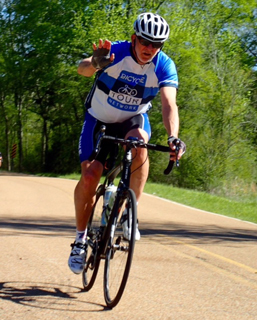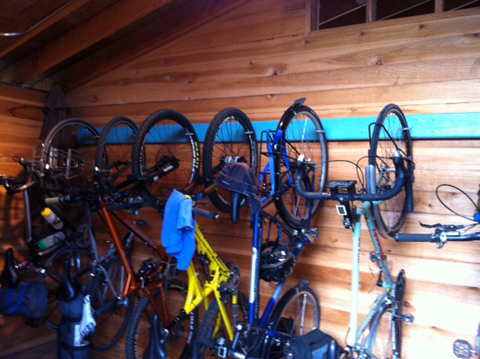Communities Capitalizing on Bicycling Boom
Cities, rural towns cater to cyclists in different ways

East Coast Greenway
Cyclists pause on the East Coast Greenway in Washington, D.C.Bicycling as a mode of daily travel is booming —cities are installing bike lanes and bike racks, creating bike share programs, and even giving bicyclist their own traffic lights. But the car is still king for nearly all trips in smaller and more rural towns—distances are just too great to make biking a realistic option for most residents.
Yet these towns are finding ways to capitalize on another aspect of the bicycling boom—the growth of recreational and sport biking. Many communities are striving to become bicycle-friendly—creating things like bike trails, signage, public education, maps showing where to take a bathroom break, and bike parking areas to attract the much-coveted cyclist with money to burn.
And becoming bike friendly for recreational bikers opens up opportunities for residents to explore biking, gradually expanding the biking mode to auto dominated areas, enhancing quality of life and supporting local businesses.
Numbers tell the story. When the nonprofit League of American Bicyclists solicited applications back in 2003 for its bi-annual program designating Bicycle-Friendly Communities across the country, there were 60 municipal applicants.
“Last year, we had 180,” says Ken McLeod, the league’s policy director. “It’s obviously a program where interest has really grown.”
The lure, McLeod said, is that “the communities get the recognition and the branding that comes with a bicycle-friendly designation. And many studies show that bike tourists tend to be of higher income, they stay in places longer, they’re working up their appetites and then they go to local restaurants.”
The league has designated 422 communities, businesses and universities as bike-friendly in all 50 states and Washington, D.C.
While cities like Portland, San Francisco and Seattle typically make the top of bike-friendly lists compiled by various pollsters, there are the less-heralded heroes, keeping up with the pack, like Ridgeland, Mississippi.
Ridgeland has a bronze designation from the League of American Bicyclists and is one of only three Bicycle-Friendly Communities in the state.

Courtesy of Gene McGree
Gene McGee, mayor of Ridgeland,
Mississippi, an avid cyclist, said bring a
bike-friendly community boosts the local
economy.“A number of years ago, we made a conscious decision to improve the quality of life for our citizens. Not just good parks and police protection, but doing things that would get people out to jog—and to bike,” says Mayor Gene McGee of Ridgeland, Mississippi. “In our transportation plan, any major roads that were going to be reconstructed would be required to have multi-use trails for people to bike, jog or just walk and enjoy.”
The 10-foot-wide asphalt trails, some that run alongside streets and some that meander into countryside, have been a draw, he says.
“Restaurants and hotels have seen a lot more activity,” McGee said. “Two different cycling shops have opened up in our little city (population 26,000). Athletic shoe stores have opened up.”
In October, the town will host Bike MS: The Mississippi 150, a two-day fundraising ride through the Mississippi countryside that will begin and end in the bicycle-friendly community. The ride offers 25, 45 and 75-mile options.
At age 69, the mayor is proud to say he bikes about 8,000 miles each year. “I get up every morning and do a 30-minute ride. Longer on the weekends,” he says. “So this is very personal, to me.”
In the community of Oak Ridge, Oregon, which is adjacent to 300 miles of single track forest trails, being bicycle-friendly means having not just bike accessible trails, signage and special events but bike-friendly businesses. The Oak Ridge Lodge and Guest House, with its accompanying bistro and café, provides locked bike storage, a bike stand with lubricant and tools so bikers can stop and make sure everything is in good working order, and a wash station.
“So when you get to the end of the day and your bike has gone a great distance, you can check the brakes, clean off the mud, check everything for safety,” said co-proprietor Lynda Kamerrer.

Courtesy of Oak Ridge Lodge
Oak Ridge Lodge in Oak Ridge, Oregon, offers amenities
for cyclists.“During peak season at the lodge, 95 percent of our guests are either road cyclists or mountain bikers,” Kamerrer said. The Lodge and similar businesses are supported by Travel Oregon, the state’s tourism commission, which has a Bike Friendly Business Program.
One of the other things that makes Oak Ridge such a bicycle-friendly town are events like The Fat 55, a 55-mile bike race, and the Cream Puff, a 100-mile race. Mountain Bike Oregon, meanwhile, is not a race but a road bike event that raises money to fund rural communities to benefit cycling.
In New Jersey, the 50-mile Tour of Somerville, which began in 1940, has become known as “The Kentucky Derby of cycling,” attracting elite cyclists from around the world. The races, held annually on Memorial Day weekend, also serve as a festival that brings thousands of spectators to Somerset County.
These high profile bike races feed the ambitions of weekend riders which in turn gives impetus to efforts to create or expand long distance biking trails. Many rural communities sit astride unused and often abandoned railroads and other transportation assets that are prime for conversion to biking trails. Several national organizations, including the Adventure Cycling Association, are devoted to Rails-to-Trails projects.
For the past eight years, the association is also leading the development of the U.S. Bicycle Route system, which, when complete, will offer more than 50,000 miles of routes for cyclists.
Lisa McKinney, Adventure Cycling’s communications director, describes the route system as “an interstate highway system for bicycles.”
On the eastern seaboard the East Coast Greenway is under development to provide a continuous 3,000-mile route from Florida to Maine. New Jersey’s portion stretches along rural areas and threads through dense urban neighborhoods and over the George Washington Bridge. Bike trails are also part of the Morris Canal Greenway, which the North Jersey Transportation Planning Authority is studying with the hope of creating a 102-mile continuous trail.
Part of what Adventure Cycling does, in addition to working with federal officials to designate and add signage along these interstate routes that span the nation, is to encourage the municipalities they pass through to capitalize on the asset, doing all they can to promote the routes and thus reap the economic benefits that come with them.
“On average, a bicyclist over 500 miles during an eight-day period will spend $600. Over the same 500 miles, someone driving will spend $360 in five days,” Sullivan said. “The main reason for why local economies are benefiting is that bicycle traveling is slower, so they tend to stop in small communities and spend more money.”
John Petrick is a freelance writer based in Jersey City, New Jersey.